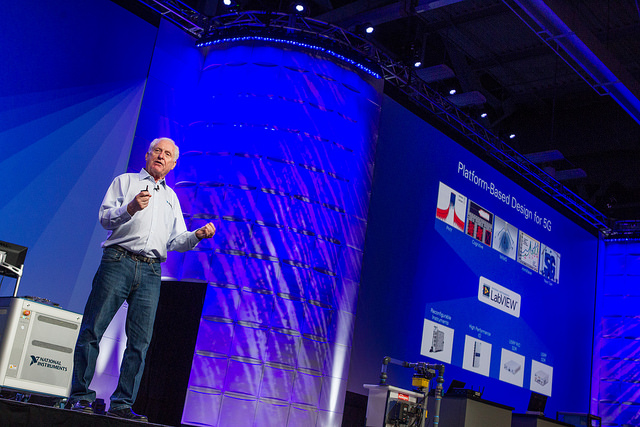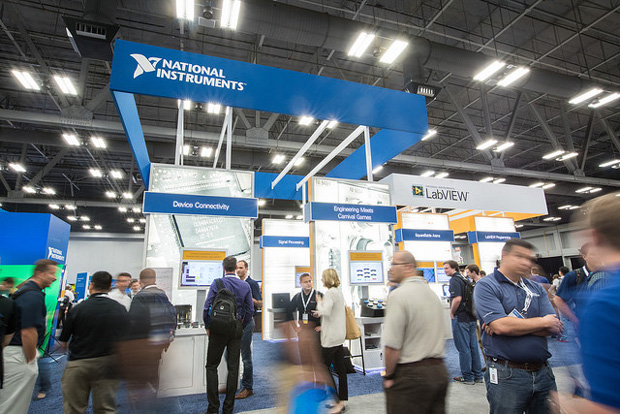
DR. T addresses attendees at NIWeek 2016.
Latest News
August 23, 2016
 This year’s NIWeek showcased a variety of hardware and software improvements for test and measurement. Image courtesy of National Instruments.
This year’s NIWeek showcased a variety of hardware and software improvements for test and measurement. Image courtesy of National Instruments.You’ve heard the expression “everything’s bigger in Texas,” and National Instruments’ (NI) NIWeek is no exception. This year’s event, from August 1-4, in Austin, played host to over 3,200 engineers for the latest announcements in test and measurement. The three-day event was packed with multiple info-intensive keynotes, product demonstrations, training courses and the latest LabVIEW release.
“There’s pent up information and data in things,” said Tom Bradicich, VP and GM, Servers & IoT Systems at HP Enterprise. “In [these things] there’s information, but nobody’s ever tapped it by perhaps looking at it or listening to it.” However, with the portfolio of technology at this year’s event, it’s apparent that engineers will be able to stock up on an array of products to take advantage of the ever-growing data revolution facing design engineering teams.
Among this change, NI noted, is the shift from closed, defined silos within departments to user-defined systems. “The real power is in the software,” said Eric Starkloff, executive vice president, Global Sales and Marketing at NI. Ultimately, NI is using its offerings to help bring software-based engineering to six key areas: acquisition and control, analysis, presentation and visualization, synchronization, FPGA (field programming gate array) and open connectivity.
Products and Applications For All
This year’s event featured a number of new product announcements, which spanned a range of hardware and software. “We’ve been working to this day to expand our capability. You’ll see new products with wider bandwidth, higher frequency ranges at this time,” said James Truchard, president, CEO and co-founder of NI. “The software-based approach fundamentally allowed us to follow Moore’s Law, [so we] could protect your software investment and take the benefits of ever more-powerful PCs and data acquisition software.”
Next-generation advancements for a new era of test and measurement. #NIWeek pic.twitter.com/JSxic7dZDq
— Desktop Engineering (@DEeditor) August 2, 2016
Beyond its software developments, NI had several big hardware announcements for engineers. These included a new Hardware-in-the-Loop Simulator, Time-Sensitive Networking Enabled Controllers, a MIMO Application Framework and a second-generation Vector Signal Transceiver (VST).
Partnered with NI’s software programs, the company hopes to set the stage for next-generation cyberphysical testing, which “brings the real world into test,” Truchard explained. With the HIL Simulator, users can customize test systems to include camera data, RF measurement and generation for radar targets, and reuse existing models through VeriStand or third-party software. It is customizable through open software and modular PXI and CompactRIO instrumentation. Under early access testing, Time-Sensitive Networking is part of NI’s work to develop new standard technologies for synchronization and communication. Mechanisms deliver distributed, hard real-time systems over standard Ethernet.
The PXIe-6570 Digital Pattern Instrument and Editor was also announced, which enables test capabilities for ICs (integrated circuits) commonly found in wireless and IoT devices.
Each of these hardware announcements brought a partner to the main keynote stage, where attendees could see these applications in action. Major industry partners included Audi, Flowserve, Saab, Murchison Wide Field Array, SanDisk and more. Each of these industries demonstrated specific use cases — from collecting satellite data, powering energy networks, expanding storage class memory and even improving autonomous car radar.
A look at the hardware behind the demos from this morning’s #NIWeek keynote. @NIglobal pic.twitter.com/xDK2AIy7wP
— Desktop Engineering (@DEeditor) August 2, 2016
An Anniversary of LabVIEW
“It wouldn’t be NIWeek if we didn’t have a new version of LabVIEW. One of our common themes is to make every user of LabVIEW more productive,” noted Ajit Gokhale, senior vice president of Global Marketing. With LabVIEW 2016, NI introduced several new key features to its flagship software—including additional channel wires and new way for users to test upcoming software capabilities.
“Our customers know the problems they want to solve, and we really want to provide them an open, flexible platform to do so,” Gokhale added.
The highlight of this 30th-anniversary release is new channel wires. “Ever since LabVIEW 1.0, we’ve been concerned on how to enable communication between parallel loops. Initially, we rationalized it wasn’t an important issue for early test and measurement. Now, we’ve finally figured out how to represent this asynchronous communication,” said Jeff Kodosky, NI co-founder, fellow and father of LabVIEW. This new connection can help streamline different programming blocks.
Additionally, LabVIEW is heading to the web through the addition of Web VIs. According to Jeff Phillips, section manager, Product Marketing at NI, they’re a way that customers can take the software and build a LabVIEW application that will run in the cloud, mobile or through a web browser without needing to access the entire environment.
For future development, licensed LabVIEW users will have access to the Software Technology Preview. This development program launches features for beta testing right as R&D releases them, letting users provide feedback and guide the software for applications. Among the first features showcased included next-generation graphical programming for desktop data acquisition, cloud-based server-side data management and analytics, and interactive functionality.
Making an Impact
The handful of customer use cases demonstrated on the main keynote stage throughout NIWeek weren’t the only projects under the spotlight. This year also include the annual Engineering Impact Awards, where research teams all around the globe can enter and showcase their best use of NI hardware and software. Categories spanned industries including aerospace, electronics, energy, industrial machinery, transportation, wireless and advanced research.
The overall best customer application of the year came from an academic collaboration between the University of Bristol and Lund University. “Setting a World Record in 5G Wireless Spectrum With Massive MIMO,” which also garnered the Engineering Grand Challenges Award, HPE Edgeline Big Analog Data Award and the Powered by Xilinx Award, set to address the growing demand for data processing faced by today’s wireless networks.
The team successfully demonstrated greater than 20x increases in bandwidth efficiency compared to current 4G cellular technologies, which opens up new, record-setting realms of possibility for 5G deployment sub-6 GHz bands, NI explains.
What’s Next?
As NI’s customers enter an age of extreme data processing and more complex designs, the company is using its clout within the industry to help engineers take advantage of software-based systems and devices. Whether it’s through new hardware and software, or industry partnerships, collaboration is at the center of NI’s plans for ensuring today’s engineers can develop next-generation products.
“Engineers and scientists are driving innovation in every industry and investing in new technologies that raise the standard of living for people around the globe,” said Starkloff. “At NI, we’re very proud to enable and accelerate this innovation.”
Subscribe to our FREE magazine, FREE email newsletters or both!
Latest News
About the Author
Jess Lulka is a former associate editor for Digital Engineering. Contact her via [email protected].
Follow DERelated Topics





